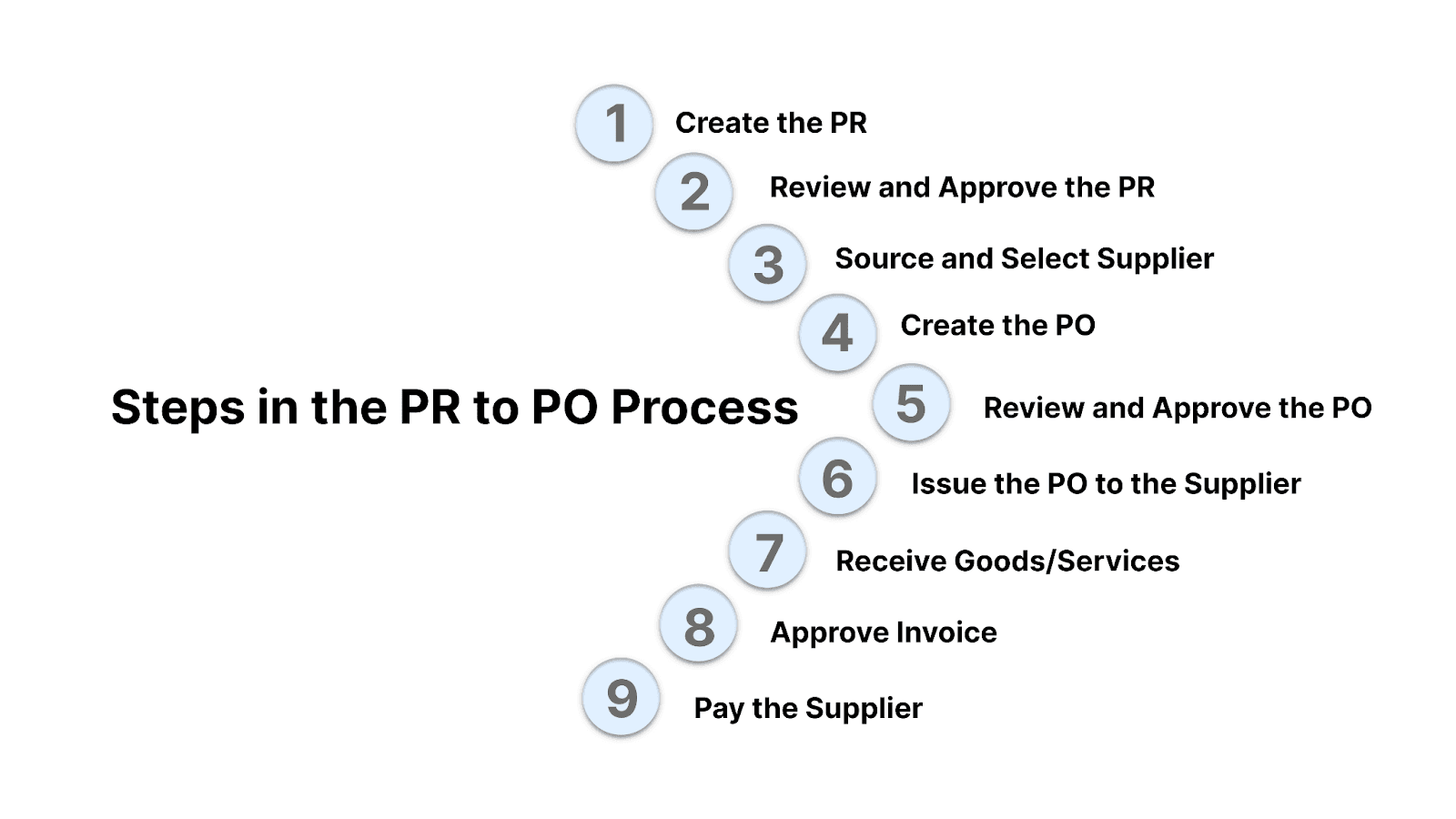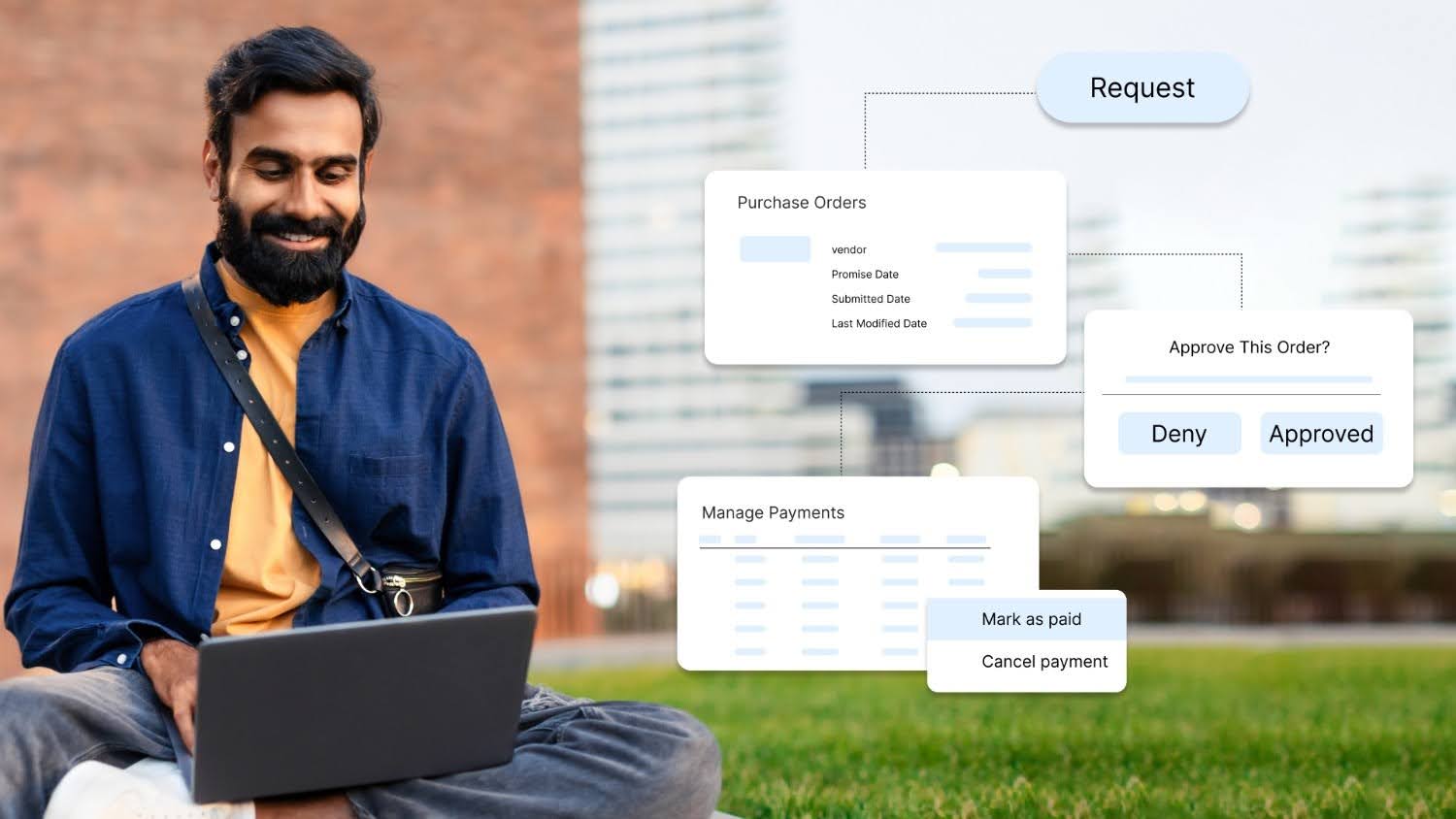Choose Smarter Spend Management Today!
As a company grows, so does the number of purchases, software subscriptions, office supplies, vendor services, and everything in between. Tracking these expenses becomes chaotic without a straightforward process. Approvals get missed, and teams often spend outside their budgets.
That's why most finance and procurement teams set up a PR to PO process, a simple way to manage internal requests, approvals, and vendor orders without letting things slip through the cracks.
In this article, we'll discuss the PR to PO process and the steps involved and highlight where most teams encounter difficulties. We’ll also show how having the right workflow and tool can save time and money.
What is the PR to PO Process?
The PR to PO process helps companies manage purchases efficiently, ensuring that no purchases are made without proper approval. It starts with a team member requesting an item or service (a Purchase Requisition, or PR) and ends with the finance or procurement team approving the request and creating a Purchase Order (PO) for the vendor.
Here's how it works in simple terms:
Purchase Requisition (PR): This is an internal request raised by an employee or department when they need to buy something, like software, hardware, services, or materials. It typically includes what they want to buy, why it's needed, and the estimated cost.
Purchase Order (PO): Once the PR is reviewed and approved, a formal order is created and sent to the vendor. This PO outlines the agreed details, quantity, price, payment terms, and delivery schedule, making the order official.
Together, this process ensures that nothing gets purchased without approval, vendors have a clear order to fulfil, and finance teams can track spending accurately. It also creates a solid audit trail, something that's often missing in informal or chat-based purchase requests.
Now that the basics are clear, let’s look at how the process works in real business environments, from the moment a need arises to the final vendor confirmation.
Also Read: What are Accounts Payable Automation Key Strategies, Benefits, and Challenges
The Key Steps in the PR to PO Process

From identifying the need for goods or services to finalising the purchase order, each stage requires attention to detail and clear communication. Here is a clear, step-by-step guide for you:
1. Create the PR
An employee or department identifies a need for goods or services and fills out a purchase requisition form with all relevant details (item description, quantity, budget code, delivery date, etc.).
2. Review and Approve the PR
The department head and/or procurement team review the PR to ensure it meets requirements and is within budget.
If approved: The process moves forward
If rejected: Feedback is provided, and the process is restarted.
3. Source and Select Supplier
The procurement department requests and evaluates quotes or bids from potential suppliers. A supplier is selected based on criteria such as price, quality, delivery time, and reputation.
4. Create the PO
Once the PR is approved and the supplier is selected, a PO is created. The PO includes all necessary details:
Vendor
Item description
Quantity
Price
Delivery date
Payment terms
5. Review and Approve the PO
Authorised personnel review the PO to ensure it’s accurate and complies with internal policies. Any discrepancies are addressed before moving forward.
6. Issue the PO to the Supplier
The approved PO is sent to the supplier, marking the official start of the procurement process.
7. Receive Goods/Services
The supplier delivers the goods or services as specified in the PO.
8. Approve Invoice
Upon receiving the invoice, it is compared to the PO and the goods/services received. Any discrepancies are resolved at this stage.
9. Pay the Supplier
The accounts payable team processes the payment based on the terms outlined in the PO.
While the process itself is straightforward on paper, most teams struggle with delays, errors, and inefficiencies. The good news? These aren’t problems you need to accept; they can be resolved with the right systems in place.
Also Read: Why Automate Procure-to-Pay: A Game Changer for Modern Business
What’s Holding Back Your PR to PO Flow? Common Issues
The PR to PO process is essential for ensuring smooth procurement, but companies often face several challenges that slow down the workflow. Let’s look at some of the most common issues:
Missing or Delayed Approvals: Requests can get stuck in inboxes or passed between departments, causing delays in approvals. This not only slows down the process but also disrupts timelines and can delay vendor deliveries.
Manual Data Entry at Every Step: Repeating the same information across PRs, POs, invoices, and accounting tools wastes time and increases the chances of errors.
Lack of Visibility Across Teams: Without a central dashboard, it’s hard to know where a request stands, who needs to act next, or whether a vendor has already been paid.
Untracked or Off-Policy Purchases: When employees find the approval process too slow or unclear, they might bypass it altogether. This leads to unapproved purchases that are hard to reconcile or justify during reviews or audits.
Disjointed Vendor Communication: When purchase orders are shared via email and follow-ups happen over calls or chats, important context gets lost. This fragmented communication often leads to misunderstandings and errors.
Difficulties During Audits or Reviews: Without proper logs or approvals, finance teams are left stitching together trails during audits, often weeks or months after the actual purchase happened.
Fixing these challenges doesn’t require overhauling your entire procurement stack; it just needs a system that understands where things break and how to keep them flowing. This is where automation and communication strategies come in.
How to Make the PR to PO Process Work for You

The process from PR to PO is critical in procurement, but it can often be inefficient and error-prone if not properly managed. By streamlining this process, organisations can improve visibility, reduce manual errors, and accelerate the purchasing cycle. Here's how you can enhance the PR to PO flow:
1. Seamless Integration and Data Transfer
Integration with Procurement Systems: Purchase requisition software integrates directly with procurement and ERP systems, automatically transferring data from PRs to POs without manual re-entry. This reduces errors and saves time by eliminating redundant tasks.
Centralised Data Management: All relevant information is stored and managed in a single platform, ensuring that data remains consistent and accessible throughout the procurement cycle.
Supplier Collaboration: Integrated systems often include supplier portals or EDI capabilities, allowing for direct communication and faster transmission of POs to suppliers, which improves supply chain efficiency.
2. Automated Workflows and Approval Processes
Automated Routing and Notifications: Purchase requests are automatically routed to the appropriate approvers, with notifications sent to prompt timely reviews. This reduces bottlenecks and speeds up the approval process.
Customisable Approval Chains: Organisations can configure workflows to match their business rules, specifying who must approve different types of expenditures and what happens if a reviewer is unavailable.
Automatic PO Generation: Once a PR is approved, the system can automatically generate a PO, minimising manual intervention and accelerating the procurement cycle.
3. Data Validation and Error Prevention
Predefined Validation Rules: Systems can enforce validation checks on fields such as recipient, delivery date, and budget codes, preventing errors before data is submitted or converted to a PO.
Audit Trails and Compliance Tracking: Automated systems maintain detailed audit trails of every step in the process, supporting compliance and making it easier to resolve discrepancies or respond to audits.
Reduced Manual Data Entry: By minimising manual input, automation reduces the risk of human error and ensures that data is accurate and consistent across all stages of the procurement process.
Your finance team has better things to do than enter the same numbers twice. Kodo keeps your PRs, POs, and vendor data in sync automatically.
4. Improving Communication and Collaboration
A big reason the PR to PO process falls apart isn’t just the tools; it’s the disconnect between teams. Here's how improving communication across departments (and with vendors) can help tighten the workflow:
Centralised Procurement Platforms: Use shared dashboards for real-time visibility into the process.
Instant Messaging and Notifications: Enable quick feedback and updates with easy-to-use communication channels.
Clear Communication Channels: Provide straightforward channels for interdepartmental and supplier communication to prevent delays.
Collaborative Tools: Use collaborative document editing and shared checklists to keep everyone on the same page.
Regular Cross-Functional Meetings: Schedule regular check-ins to align objectives and address concerns.
Supplier Portals for Direct Communication: Integrate portals to streamline communication with suppliers and avoid miscommunication.
When the process works as it should, it doesn’t just reduce chaos, it creates real business value. From faster turnarounds to better compliance, here’s what an optimised PR to PO flow unlocks.
What You Gain from an Optimised PR to PO Workflow
Here are the kinds of wins teams start to see when the PR to PO process actually works the way it should.
Time Savings: Automation and seamless data transfer eliminate manual steps, accelerating the entire procurement cycle and allowing faster delivery of goods and services.
Reduced Errors: Automated workflows and data validation minimise the risk of manual entry mistakes, ensuring accuracy in order details such as quantity, price, and delivery dates.
Enhanced Budget Control: The process ensures purchases are reviewed and approved before funds are committed, preventing overspending and unauthorised purchases.
Improved Visibility and Transparency: Centralised systems provide real-time tracking of requests, approvals, and orders, making it easier to monitor spending and procurement activity.
Stronger Supplier Relationships: Clear, formal purchase orders and timely communication foster trust and reliability with suppliers.
Streamlined Approval Workflows: Automated routing and notifications speed up approvals and reduce bottlenecks, improving overall efficiency.
Compliance and Audit Readiness: Detailed records of requisitions and purchase orders support compliance with internal policies and external regulations, simplifying audits and financial tracking.
Strategic Sourcing Opportunities: Procurement teams can leverage consolidated data to negotiate better terms and identify cost-saving opportunities.
Reduced Fraud Risk: Multiple layers of documentation and approval help prevent unauthorised or fraudulent purchases.
But before you get there, it’s worth recognising what might be slowing your team down today. These are some of the most common breakdowns companies face when managing requests and approvals manually.
How Kodo Simplifies the PR to PO Process
Most procurement tools treat PR to PO like a checklist. But in reality, it's a flow, dynamic, time-sensitive, and often tangled in back-and-forth across teams, tools, and email threads. The longer it takes to move a request to a purchase order, the more time, context, and control you lose.
Kodo doesn’t just digitise the process. It rethinks it. Instead of forcing your team to work around rigid systems or outdated ERP layers, Kodo gives finance and ops leaders a clean, connected way to handle purchase requests, approvals, orders, and payments, all in one place, minus the mess.
It's not a band-aid on broken workflows. It's a system that understands why they break in the first place.
What Kodo Brings to the Table
Intake-to-Pay in One Flow: From the moment a request is raised to when the vendor is paid, the entire journey lives inside Kodo. Nothing slips through, no steps scattered across tools.
Approval Chains That Work: Kodo lets you build custom approval paths with clear logic, instant notifications, and complete visibility.
Zero Manual Re-entry: Once a request is approved, Kodo auto-generates the PO with exact vendor terms, pricing, and delivery details.
Clean Vendor Coordination: POs don't just get sent out. They're acknowledged, tracked, and matched with invoices. Kodo keeps suppliers in the loop without needing a hundred follow-ups.
Powerful Integrations: Whether it's Tally or Zoho Books, data flows in and out without duplication or lag. Your books stay clean and current.
Wrapping Up
Procurement isn’t just about getting things approved. It’s about building systems that scale with your company’s pace. As teams grow, so does the pressure on finance to balance speed with control. That’s where having a dependable, transparent PR to PO process does more than streamline purchases. It sets the foundation for better vendor relationships, smarter forecasting, and stronger financial governance.
If you're at a stage where manual processes are starting to feel like a bottleneck, it’s probably time to shift the lens from fixing individual issues to redesigning the workflow entirely. The real advantage isn’t just automation; it’s having a setup that works even when your business outgrows the spreadsheet.

Don’t let manual workflows hold back your finance team. Start using Kodo to manage purchase requests, approvals, and payments, all in one streamlined platform. Book your demo now.

